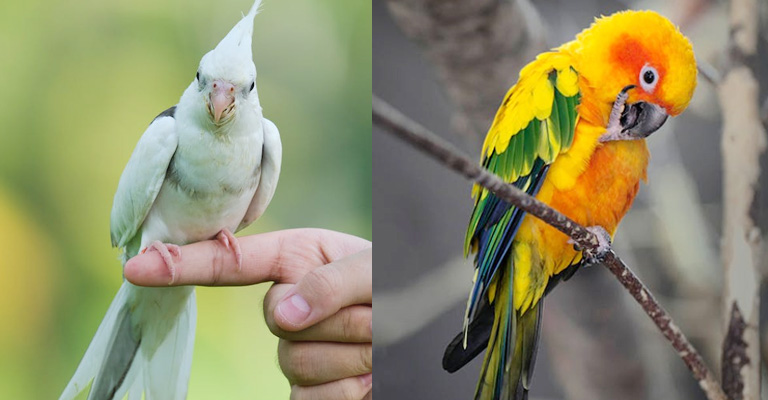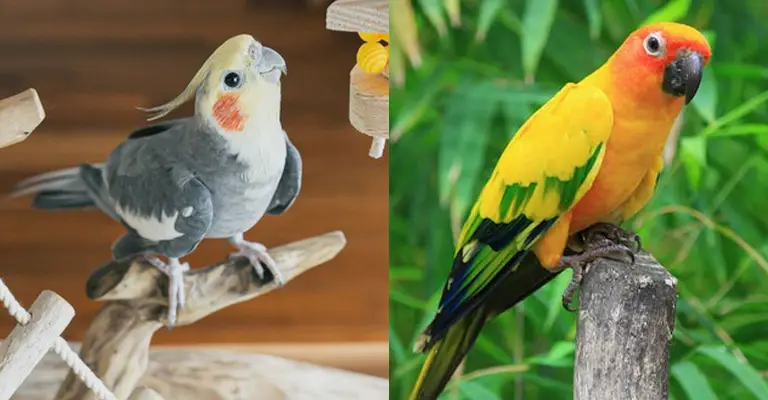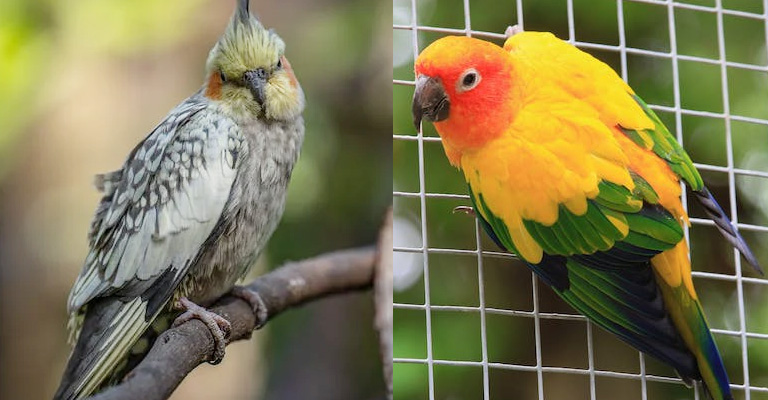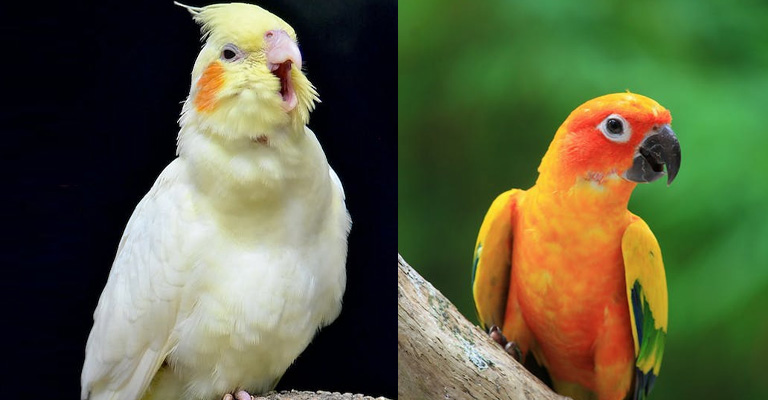When it comes to choosing a pet bird, two popular options that often capture the hearts of bird enthusiasts are the cockatiel and the conure.
Both the cockatiel and conure belong to the parrot family, showcasing vibrant feathers, playful personalities, and the ability to mimic human speech.
While these avian companions share some similarities, they also have distinct characteristics that set them apart.
In this article, we will explore the similarities and differences between cockatiels and conures, helping you make an informed decision when considering which one may be the ideal pet bird for you.

Size and Appearance
The easiest way to identify a cockatiel and conure is to check their size and physical appearance. They have a lot of differences in this section.
The Size and Physical Features of Cockatiels
Cockatiels are known for their elegant and graceful appearance. They typically measure around 12-14 inches (30-36 cm) in length from head to tail and weigh around 3.5-4.5 ounces (100-130 grams).
Cockatiels have a compact body with a round head, a long, slender beak, and expressive eyes. They are known for their distinctive crest, which can be raised or lowered depending on their mood or level of alertness.
The plumage of cockatiels is predominantly gray, with varying shades and patterns. Male cockatiels usually have brighter and more vibrant plumage, with a prominent yellow face and orange cheek patches, while females have a duller appearance.
The Size and Physical Features of Conures
Conures, on the other hand, have a more vibrant and colorful appearance. They range in size from small to medium, with some species being smaller than cockatiels and others being slightly larger.
On average, conures measure around 10-16 inches (25-40 cm) in length and weigh approximately 3-6 ounces (85-170 grams). Conures have a stocky build with a sturdy beak and a broader tail compared to cockatiels.
Their plumage comes in a wide variety of colors, including green, blue, yellow, orange, and multicolored combinations. Each conure species has its own unique coloration and markings, making them visually striking and captivating.
The Differences in Appearance Between the Two Species
The most notable difference in appearance between cockatiels and conures lies in their plumage and color variations.
While cockatiels primarily exhibit shades of gray with distinctive yellow faces and orange cheek patches in males, conures showcase a vibrant palette of colors that can vary greatly depending on the species.
Conures have a wider range of options for those seeking a visually striking and colorful parrot.
Cockatiels and conures differ in size, with cockatiels being slightly larger on average. Cockatiels have a more subdued coloration, with predominantly gray plumage and distinct gender-based differences, while conures boast a wide array of colorful feathers.
The choice between the two will ultimately depend on personal preference for either a more elegant and gentle appearance (cockatiels) or a vibrant and visually appealing display (conures).
Personality and Behavior: Cockatiels Vs. Conures

To understand the differences between Cockatiels and Conure, you should also learn about their personality and behavior.
The General Personality Traits of Cockatiels
Cockatiels are known for their gentle and docile nature, making them popular choices for bird enthusiasts seeking a calm and peaceful companion. They are generally sweet-tempered birds and are known to be affectionate towards their owners.
Cockatiels often form strong bonds with their human companions, seeking interaction and physical contact. They enjoy being petted, cuddled, and often perch on their owners’ shoulders or laps.
Cockatiels are known to be relatively easygoing and can adapt well to various living situations.
The General Personality Traits of Conures
Conures, on the other hand, are characterized by their energetic and outgoing personalities. They are highly active birds and thrive on mental and physical stimulation.
Conures are naturally playful and curious, often exploring their surroundings and engaging in various activities. They enjoy toys, puzzles, and interactive playtime with their owners.
However, it is important to note that there are variations in the behavior and temperament among different conure species. Some conures can be more vocal and noisy, while others may be relatively quieter.
It is essential to research specific conure species to understand their unique characteristics before making a decision.
Cockatiels are generally known for their gentle and affectionate nature, bonding closely with their owners and providing a calm and peaceful companionship.
Conures, on the other hand, exhibit more energetic and playful behavior, often displaying curiosity and seeking interactive stimulation.
It is important to consider your own lifestyle, preferences, and ability to provide the necessary mental and physical enrichment when choosing between these two species.
Ultimately, understanding the general personality traits of cockatiels and conures can help you make an informed decision based on the type of parrot companion you desire.
Intelligence and Trainability
Cockatiels and conures are both considered intelligent parrot species. They possess the capacity to learn and understand various commands and behaviors.
Cockatiels, in particular, have shown remarkable intelligence in tasks such as mimicry and learning simple tricks. They are quick learners and can easily grasp concepts with consistent training and positive reinforcement.
Similarly, conures exhibit intelligence and can learn a wide range of tricks and behaviors.
Highlighting the Trainability: Cockatiels Vs. Conures

Both cockatiels and conures can be trained with patience, consistency, and positive reinforcement techniques. Cockatiels are generally known for their trainability and willingness to learn.
With regular training sessions and rewards, they can be taught to step up, perform tricks, and even mimic certain sounds or words.
Conures, with their curious and playful nature, also respond well to training and can be taught various commands and behaviors.
Learning Abilities and Problem-solving Skills
In terms of learning abilities and problem-solving skills, cockatiels and conures may exhibit some differences. Cockatiels tend to have a slightly more cautious and observant nature, which can make them excellent problem solvers.
They have shown the ability to solve simple puzzles and navigate through obstacles. Conures, with their high energy and inquisitive nature, may be more inclined to explore their environment and interact with toys or puzzles.
When it comes to intelligence and trainability, it is important to note that individual birds within each species can vary in their aptitude and willingness to learn.
Some cockatiels may have exceptional learning abilities, while others may require more time and patience. The same applies to conures, where certain species may showcase higher levels of intelligence and trainability compared to others.
Vocalization

Cockatiel and Conure share a lot of differences in their vocalization. Here are the facts you need to know.
Vocalizations of Cockatiels
Cockatiels are known for their wide range of vocalizations. They have a repertoire that includes chirps, whistles, trills, and melodic songs. Cockatiels often communicate through a combination of short, high-pitched calls and longer, melodious tunes.
They may also mimic certain sounds or words they hear regularly in their environment. Cockatiels are capable of mimicking human speech, although their vocal abilities in this regard may not be as developed as larger parrot species.
Vocalizations of Conures
Conures, on the other hand, are lively and expressive vocalizers. They have a diverse range of vocalizations, including squawks, screeches, chatters, and various other unique sounds.
Conures are known for their enthusiastic calls, which can vary from loud and raucous to soft and gentle. Some conure species are even capable of mimicking human speech and can learn to repeat words or phrases with proper training and repetition.
Noise Level Differences: Cockatiels Vs. Conures
When comparing the potential noise levels between cockatiels and conures, it’s important to note that both species have the ability to create considerable sound.
Cockatiels, while capable of emitting loud calls and songs, tend to have a more moderate noise level overall. Their vocalizations can vary in intensity and volume, but they are generally not as loud as those of some conure species.
Conures, being highly energetic and expressive birds, can produce louder and more frequent vocalizations. Their natural exuberance and tendency to be more vocal may result in a higher noise level in the household.
Biting Tendency
Both cockatiels and conures have the potential for biting, although the likelihood and severity can vary between individuals and circumstances.
It’s important to recognize that biting is a natural behavior for parrots, and it serves various purposes in their wild habitats, such as defense, establishing boundaries, or expressing discomfort.
However, not all cockatiels or conures will display biting tendencies, and the frequency and intensity of biting can differ among birds.
Individual Bird Personalities Can Vary Within a Species
Just like humans, birds have individual personalities that can differ even within the same species. While certain generalizations can be made about cockatiels and conures, it’s crucial to remember that not every bird will exhibit the same behavior.
Some cockatiels may be more prone to biting due to their inherent disposition, while others may be gentler and less inclined to bite. Similarly, within the conure species, individual birds may vary in their temperament and propensity for biting.
Importance of Proper Socialization and Training
Proper socialization and training play a significant role in minimizing biting behaviors in both cockatiels and conures.
Early and consistent socialization can help birds become accustomed to human interactions, different environments, and handling, reducing their fear or defensive responses.
Positive reinforcement training techniques can be employed to encourage desirable behaviors and discourage biting.
Providing appropriate toys and outlets for natural behaviors, such as chewing and foraging, can also help redirect their energy and reduce the frustration that may lead to biting.
Additionally, understanding the body language and vocal cues of cockatiels and conures is crucial for recognizing their emotional states and potential triggers for biting.
What Should I Choose From Cockatiels and Conures?
Choosing between a cockatiel and a conure as a pet depends on your preferences. Cockatiels are smaller, gentle, and affectionate, while conures are more energetic and playful.
Cockatiels are quieter, while conures can be more vocal. Both require similar care in terms of diet, housing, and interaction.
Consider your space, noise tolerance, and the time you can dedicate to your pet when making a decision. Visiting a breeder or rescue center can help you interact with both species before deciding.
Now, check out the following comparison table to decide properly. Make sure to prioritize all the features in the context of your personal preferences.
Comparisons at a Glance: Cockatiels Vs. Conures
| Aspect | Cockatiels | Conures |
| Size | Smaller | Varies (small to medium-sized) |
| Appearance | Crested head, long tail feathers | Vibrant plumage, varying colors |
| Personality | Gentle, docile, affectionate | Energetic, outgoing, playful, curious |
| Intelligence and Trainability | Intelligent and trainable | Intelligent and trainable |
| Vocalization | Whistles, chirps, limited vocabulary | Variety of vocalizations, extensive vocabulary potential |
| Biting Tendency | Generally low, may bite if provoked | Varies depending on individual bird and socialization |
| Noise Level | Relatively quiet | Can be loud, especially during certain times of the day |
| Lifespan | 10-20 years | 15-30 years |
| Living Situation | Suitable for apartments | Require adequate space for movement and play |
FAQs
It is generally not recommended to keep cockatiels and conures together in the same cage. They have different needs, temperaments, and sizes, which can lead to potential conflicts or stress.
It’s best to provide each bird with its own suitable and spacious living environment.
Yes, both cockatiels and conures have specific dietary requirements. Cockatiels thrive on a balanced diet consisting of high-quality bird pellets, fresh vegetables, fruits, and occasional seeds.
Conures also require a similar diet with the addition of nuts, grains, and protein sources like cooked chicken or eggs. It’s important to provide a variety of nutritious foods and consult with a veterinarian for specific dietary recommendations.
Cockatiels are generally known for their relatively quiet nature, with soft chirps, whistles, and occasional vocalizations. Conures, on the other hand, can be quite vocal and have a wide range of vocalizations, including loud calls and screeches.
However, noise levels can vary among individual birds, and proper training and socialization can help minimize excessive noise.
Yes, both cockatiels and conures benefit from regular veterinary check-ups. Routine examinations can help detect any health issues early on and ensure their overall well-being.
Additionally, it’s important to provide them with proper vaccinations, parasite prevention, and annual bloodwork to monitor their health.
While cockatiels have limited speech abilities and can mimic a few words or phrases, they are not known for their talking abilities compared to some other parrot species.
Conures, on the other hand, have a greater potential for learning and can develop a more extensive vocabulary with proper training and social interaction.
Wrapping Up
Both cockatiels and conures are wonderful avian companions, each with its own unique characteristics. Consider your preferences, living situation, and the specific needs of each species when making a choice.
Spend time with them to assess compatibility, and remember that proper care, socialization, and training play key roles in shaping their behavior.
Enjoy the journey of sharing your life with these amazing feathered friends. And share your thoughts about it with us. Thanks a million times for your support.